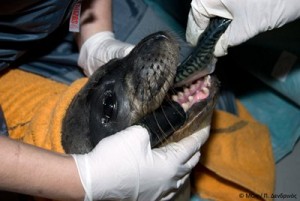 According to Turkish press reports, the veterinarian charged with beating orphaned monk seal Badem during an ill-conceived ‘aversion therapy’ programme, has received a court sanctioned fine of 848 TL. (approximately $470). It remains unclear whether the Foça town abattoir vet, Avni Gök, will be banned from future monk seal rehabilitations.
According to Turkish press reports, the veterinarian charged with beating orphaned monk seal Badem during an ill-conceived ‘aversion therapy’ programme, has received a court sanctioned fine of 848 TL. (approximately $470). It remains unclear whether the Foça town abattoir vet, Avni Gök, will be banned from future monk seal rehabilitations.
In response to questions from TMG, Turkish monk seal NGO SAD-AFAG, responsible for Badem’s rescue and on-again, off-again rehabilitation, insisted that it had neither approved nor was aware of the veterinarian’s training regime, video footage of which sparked widespread public anger. While condemning the actions of Gök, AFAG’s Cem Orkun Kirac suggested that the footage had been leaked by local opponents of AFAG rehabilitation projects, and that the veterinarian’s methods had not been inspired by cruelty or malice.
TMG’s opinion is that the training regime applied was at best driven out of ignorance and at worst represents a clear case of inexcusable animal cruelty. While Hawaiian monk seal researchers occasionally employ “aversive conditioning” to drive monk seals away from situations in which they or members of the public are deemed at risk, (1) these are applied within the specific situation in which such action is required, not in an enclosed pool where no such risk exists, and (2) utilise actions such as noise, lights or “waving a palm frond” at the animal — presumably not quite in the same league as beating it with a stick.
We understand that AFAG intends to issue an English language press release on the issue within a matter of days.
Sources: Fok Badem’i döven veterinere para cezası, Radical, 5 March 2012.
Jenkinson, E. M. 2010. Aversive conditioning and monk seal – human interactions in the main Hawaiian Islands: Aversive Conditioning Workshop, Honolulu, Hawaii, November 10-11, 2009. U.S. Dep. Commer., NOAA Tech. Memo., NOAA-TM-NMFS-PIFSC-25, 28 p. + Appendices. [PDF 268 KB]


 The huge scale of the Costa Concordia disaster is apparent in this satellite image of the stricken cruise ship just off the Italian island of Giglio.
The huge scale of the Costa Concordia disaster is apparent in this satellite image of the stricken cruise ship just off the Italian island of Giglio.